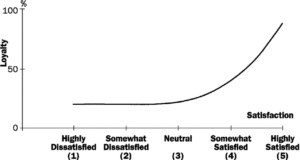
When you look at the relationship between customer satisfaction and loyalty, it would seem that it’s linear where a little more satisfaction results in an equivalent increase in loyalty. But that’s not the case. The graph below depicts what the relationship is in practical terms. 
As you can see, from highly dissatisfied to neutral (relatively happy), nothing much happens in terms of loyalty. Then, as satisfaction becomes more than mere satisfaction and turns into highly satisfied, loyalty increases sharply. What it means is that when you deliver the right service/product at the right price, at the right time, and to the agreed-upon specifications, you score a 3 or possibly a 3.5 and this does not lead to loyalty.
Independent studies confirm that highly satisfied customers are four times as likely to buy again within the next six months as customers who are merely satisfied. Conversely, customers who are merely satisfied are five times as likely to purchase from another source. The implication is that your services must be extraordinary so as to produce highly satisfied customers who become loyal.
Customer loyalty is key in driving growth and profitability in a business with research showing that a mere 5% jump in customer loyalty can boost profits 25%-85%.
Hence to achieve profitability and growth, there is only one question you need to ask your customers and one number (the answer to the question) that you need to pay attention to. The question is: On a scale of 1 to 10 how likely are you to recommend our service to a colleague or friend?
Here are the implications of possible answers:
- Answers from 1 through 6 are detractors
- Answers 7s and 8s are neutrals
- Answers 9s and 10s are promoters
1 through 6 are in reality answers that correspond to customers who will likely make a negative comment if asked to recommend your organization. The satisfied 7s and 8s are lukewarm and don’t count. Only the highly satisfied are counted and are called the promoters.
That’s why the only number you need to watch closely is the number of your customers who are promoters. This number is a reflection of loyalty.
If it’s high, and – more importantly – if it’s increasing, your organization is doing something right. If it’s decreasing, your organization is doing something wrong and is missing opportunities for growth.

